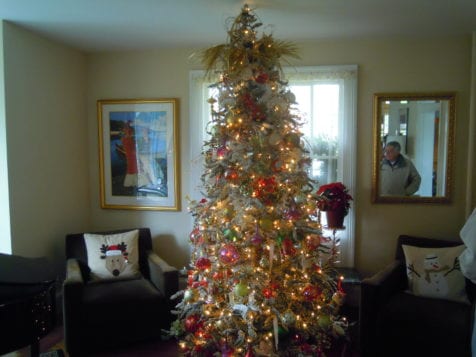By Kevin Redding
There’s no place like a historic home for the holidays.
On Sunday, Dec. 3, the Huntington Historical Society will host its 12th annual Historic Houses at the Holidays driving tour, giving residents the opportunity to explore five private historic homes and two house museums in the area from Huntington Village to Cold Spring Harbor.
Each stop on the self-guided tour will be decorated to the nines for the season; equipped with a volunteer from the historical society to answer any and all questions about the background of each location; and provide a firsthand glimpse at the original architectural styles and designs within these homes, which were built between the early 1800s and early 1900s. Visitors will be able to view bedrooms, living rooms, kitchens and even some attics of these colonial-style residences.
Approximately 300 to 400 people are expected to attend the event this year.
“The Holiday Historic Houses Tour is a real treat,” said Claudia Fortunato-Napolitano, executive director at Huntington Historical Society. “The houses on the tour are all decorated for Christmas and the refreshments are overwhelming. Come and enjoy a day out!”
The theme of this year’s tour is also the mantra of the historical society: Huntington Lives Here.
“Huntington’s history goes back to the mid-17th century and the people that came to live here were interested in building a meaningful town and leaving their imprint on it. This tour serves to highlight that,” said Toby Kissam, a trustee at the historical society and one of the tour’s chief researchers, whose ancestral home — the Dr. Daniel W. Kissam House Museum on Park Avenue — is among the afternoon’s seven stops. “Each year I find people that come on our tours know there’s going to be a great historical story with each house and I enjoy researching and telling that story. It’s always fun.”
Kissam said the oldest private home on the tour is also the one he’s most excited about: the 1820s-built Cold Spring Harbor birthplace of leading suffragette Ida Bunce Sammis, who organized the first women’s suffrage club in Suffolk County and became one of the first two women elected to the New York State Legislature in 1919. The home’s inclusion on this year’s tour correlates with the 100th anniversary of the passing of the constitutional amendment granting women the right to vote in the state of New York, Kissam added.
Also on full display is a house built in Huntington Harbor for a local sea captain in 1902; the grand 1914 Georgian-style home of New York City attorney-turned- Suffolk County representative in the New York State Assembly John J. Robinson, who was elected in 1912 and built his house on West Main Street in 1914; and a farm house constructed in the village in 1917 by Henry Willets of Dix Hills.
The most modern stop on the tour is a 1935-built summer estate in Greenlawn previously owned by a wealthy manufacturer named Walter Beh and his wife Margaret. Beh acquired the large, 110-acre property so he and his a wife, an equestrian, could raise and train horses there.
“Most of these were part-time residents, but they have contributed meaningfully to the town over years and has contributed to the place that Huntington holds today in Suffolk County and Long Island as one of the premiere towns in the region,” Kissam said.
The historical society-owned museums — both the Kissam House and the David Conklin Farm House, built in 1750 — will also be decorated for the tour. Visitors to the Kissam House will be treated to an exhibit entitled Promenade and Parasols, showcasing outfits and umbrellas from the 19th century and Victorian era, and the Conklin Barn will provide an array of refreshments from noon to 4 p.m.
Kissam, who is the great-great-great-grandson of Dr. Daniel Kissam, has naturally had a deep fascination with history his whole life, both general and Huntington-specific, and has occupied the role of genealogist in his family. This past summer, he and the rest of the Huntington Holiday House Tour Committee began their search and research of local private properties to feature.
“That’s always the challenge,” Kissam said on choosing homes to showcase during the tour. “We have to get people to agree, but we know of houses with a history and sometimes we just knock on doors and explain who we are and what we’d like to do. Usually we can talk people into it, particularly if they’re interested in what the history of their own house is. Once we run out of houses and can’t find houses maybe the tour has to stop, but we’ve been able to keep it going for the past 12 years.”
Historical society and committee member Patricia Ernst said the tours are beneficial to both those who take them and those who host them. “At the end of the day, everybody has such a good time,” she said. “The homeowners have a great afternoon having people exclaim over their houses, both the historical aspects of them and otherwise. The tour highlights these old houses and I think that’s a big draw for people who are deciding on what town they want to live in.”
Ernst continued, “Huntington has homes that have been here since the mid-1600s and that isn’t true in too many places. These houses are lovingly taken care of and are being guarded, and people in Huntington appreciate that.”
The Huntington Historical Society’s 2017 Holiday House Tour will be held on Sunday, Dec. 3 from noon to 4 p.m. Tickets are $40 for the general public and $35 for members. For more information or to order tickets, please call 631-427-7045, ext. 401 or visit www.huntingtonhistoricalsociety.org.
Photos courtesy of Huntington Historical Society










